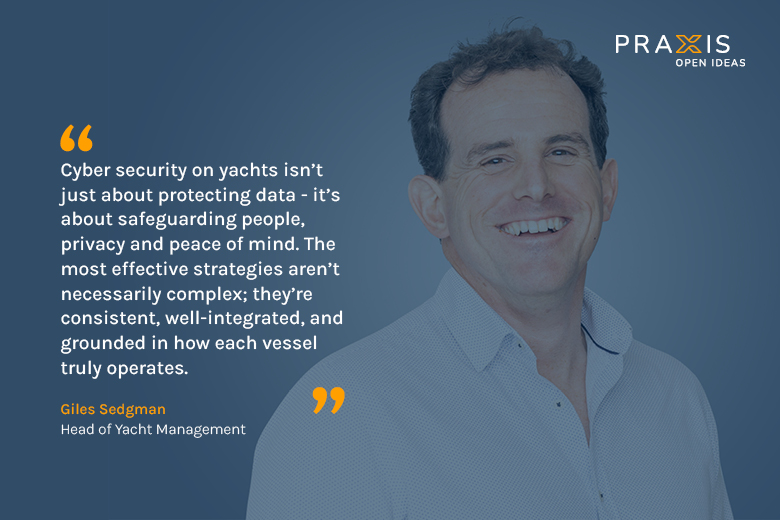
Cyber security for superyachts: Protecting people, privacy and performance
Superyachts are evolving into highly connected smart environments where navigation, engineering, entertainment and security systems operate as part of an integrated digital ecosystem.
This level of connectivity delivers exceptional guest experiences and operational efficiency, but it also creates new opportunities for malicious actors. Cyber threats no longer focus solely on data theft. They can manipulate navigation systems, disable critical functions or compromise the privacy and personal security of those on board.
As technology advances, so too does the need for a structured and proportionate approach to managing digital risk for the vessel itself and the wider digital estate of the owner, their family and their guests.
In this article, Giles Sedgman, Head of Yacht Management at Praxis, explores how cyber resilience has become a core operational priority and how owners, captains and advisers can embed it into the everyday running of their vessels.
How superyachts are being targeted
Recent reports highlight a sharp rise in maritime cyber risk. Ransomware, GPS spoofing and system interference are increasingly being directed at high-value, technologically advanced vessels many of which still lack robust protection.
Common vulnerabilities we encounter include:
- Interconnected systems often installed by multiple third parties, with varying levels of security
- Remote access granted to contractors, often with no expiry or formal review
- Limited cyber training among crew, with inconsistent awareness of attack methods
- Guest devices connecting to internal networks, increasing the attack surface
- Minimal oversight on private yachts under 500GT, which fall outside mandatory frameworks
Owners may assume that basic firewalls or anti-virus software provide sufficient protection. In reality, attacks frequently exploit outdated integrations, poor access hygiene and - in over 80% of cases - human error.
For example, on one recent vessel audit, malware entered the yacht’s system via an innocuous-looking media file loaded onto the onboard entertainment system bypassing the vessel’s antivirus and spreading unnoticed.
The broader digital ecosystem
Superyachts are rarely isolated assets. They form part of a wider digital lifestyle that often includes private estates, jets, vehicles, wearable technology, cloud-based services and family office infrastructure.
Cyber resilience must therefore be aligned across the entire ecosystem. A breach of the owner’s personal or professional digital environment can quickly cascade to the yacht and vice versa. For this reason, we advocate an integrated approach, working with yacht captains and ETOs as well as with family office teams, crews and advisers.
When digital threats impact physical safety
The International Maritime Organisation (IMO) reports that cyber intrusions can go undetected for up to 197 days, which means a vessel could be compromised long before any visible signs emerge, particularly without active monitoring.
Onboard cyber incidents can escalate rapidly:
- GPS spoofing misleading bridge crew
- Ransomware disabling lighting or navigation mid-passage
- Targeted attacks preventing access to critical systems or safety controls
In critical moments, the ability to navigate safely and respond effectively can be directly compromised.
Protecting guest experience and privacy
Superyacht guests also bring connected devices onboard, from smartphones and wearables to personal computers and media systems. This introduces additional privacy, reputational and operational risks:
- Sensitive personal data may be exposed if networks are not properly secured
- Devices may serve as entry points for attackers targeting the vessel
- Guests may be unaware of cyber hygiene protocols unless briefed clearly
We advise owners and captains to include cyber resilience for their guests, providing secure connectivity options and discreetly managing network access to ensure privacy.
Evolving regulations and expectations
While IMO Resolution MSC.428(98) mandates cyber risk management within Safety Management Systems (SMS) for vessels over 500GT, expectations are rapidly shifting across the wider market.
The European Union Agency for cyber security (ENISA) classifies maritime as a high-risk digital environment, with attackers targeting vessels and supporting shore-based infrastructure.
New classification society rules (UR E26/E27) require cyber security to be built into new builds and major refits, and insurers are beginning to scrutinise cyber readiness more closely when underwriting risk.
Owners and charter clients increasingly expect robust cyber protections to be in place for regulatory compliance as well as reputation, privacy and operational assurance.
At Praxis, we also support owners of vessels below 500GT, helping them meet and exceed IMO guidance through voluntary adoption of structured cyber resilience measures and clear, proportionate documentation within the vessel’s operational framework.
Building cyber into day-to-day yacht operations
Cyber resilience is not a one-off exercise. It must become an integral part of daily yacht operations embedded into the vessel’s SMS or ISM framework and adapted as the digital environment evolves.
We support owners and family offices by working closely with captains and operational crew to implement practical, proportionate measures:
- Mapping access points across bridge, crew and guest systems
- Refreshing user credentials and access rights regularly
- Keeping software and systems updated consistently
- Applying time-limited, logged contractor access controls
- Incorporating cyber events into safety drills and crew training
- Conducting incident response readiness planning, so crew know exactly what to do if an attack occurs
- Managing vendor and third-party risk by ensuring external partners adhere to sound cyber hygiene standards
We also provide discreet and confidential cyber reviews, giving owners and family offices a clear, realistic understanding of their vessel’s cyber resilience and the steps required to strengthen it.
For example, during one recent system review we identified multiple unused administrative accounts (a common risk point), which were subsequently removed to tighten access control.
Crew readiness: a people-first defence
From phishing links and unapproved USB devices to weak passwords and poor access discipline, human behaviour remains a major driver of cyber risk.
High crew turnover further compounds this risk, and without consistent training and onboarding processes, new crew members may inadvertently expose the vessel to attack.
We therefore place strong emphasis on practical, role-based education, including phishing simulations, secure device protocols and escalation procedures. Training must be an ongoing process, not a one-time module.
Business continuity and reputational risk
The consequences of a major cyber incident can extend beyond the vessel itself:
- Charter income can be disrupted
- Owners may face legal liabilities under GDPR and other data protection regimes
- Sensitive client or guest information may be exposed
- Publicity around an incident can cause reputational harm to the owner and their family
A sound cyber resilience strategy should therefore form part of wider business continuity and reputation management planning, and we can provide joined-up advice across your full asset portfolio.
Understanding your vessel’s cyber resilience
In our experience, superyachts typically fall into one of three broad categories when it comes to cyber readiness:

Understanding where your vessel currently stands helps you take proportionate, confident next steps, whether that’s an introductory briefing or a full security audit.
Real risk requires real readiness
Cyber threats to superyachts will only continue to evolve. However, with the right expert support and structured planning, cyber resilience becomes a natural part of safe, modern yacht management, enhancing guest confidence and protecting owners.
We act as trusted advisers to owners, family offices and yacht management teams helping you navigate this complex landscape with discretion and clarity.
To explore how Praxis can support your yacht’s cyber resilience strategy, please contact Giles for a confidential consultation.
Please note that this article is intended to provide a general overview of the matters to which it relates. It is not intended as professional advice and should not be relied upon as such. Any engagement in respect of our professional services is subject to our standard terms and conditions of business and the provision of all necessary due diligence. © Praxis 2025

